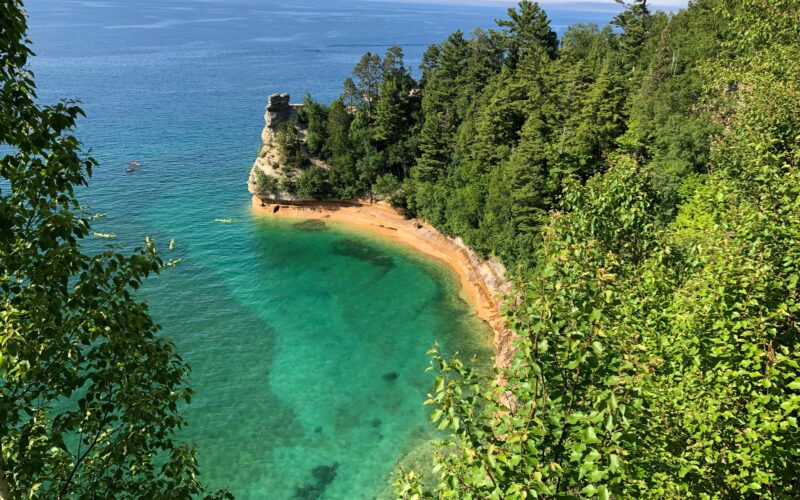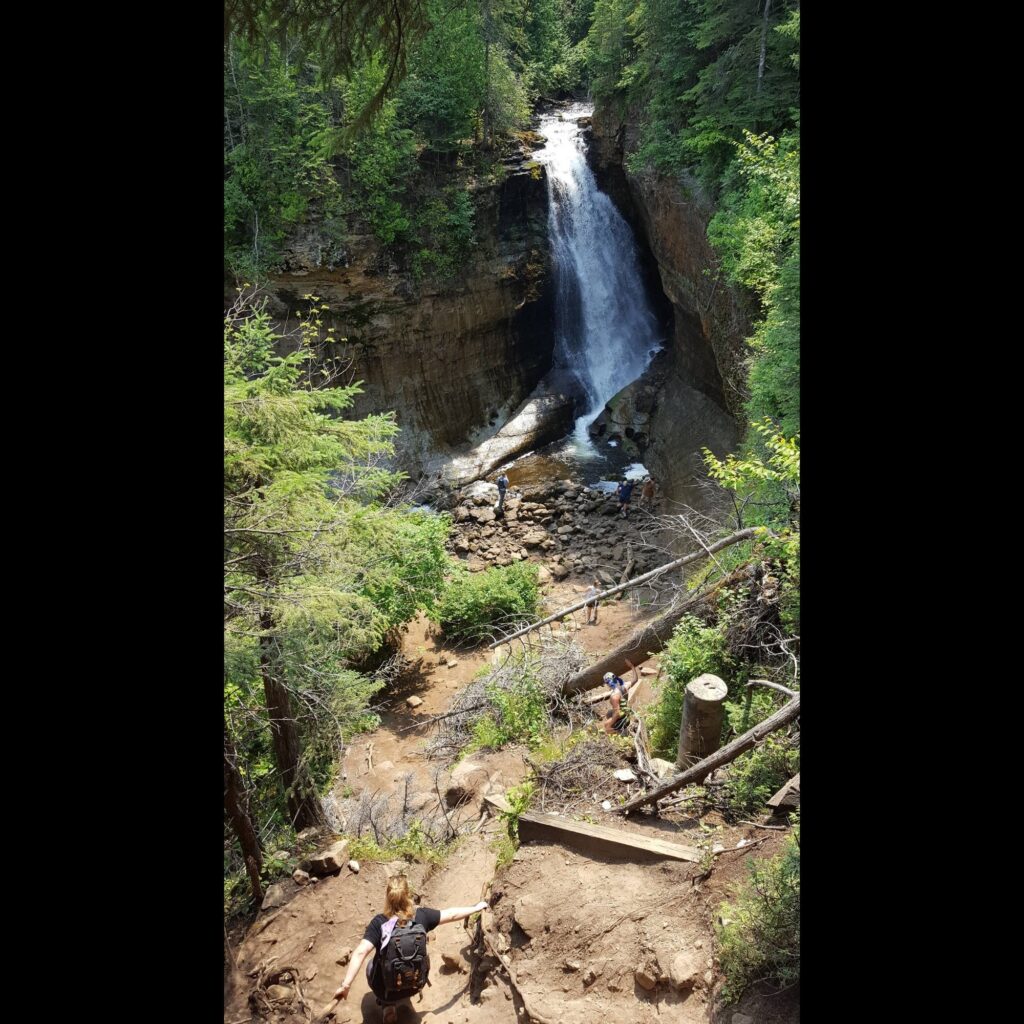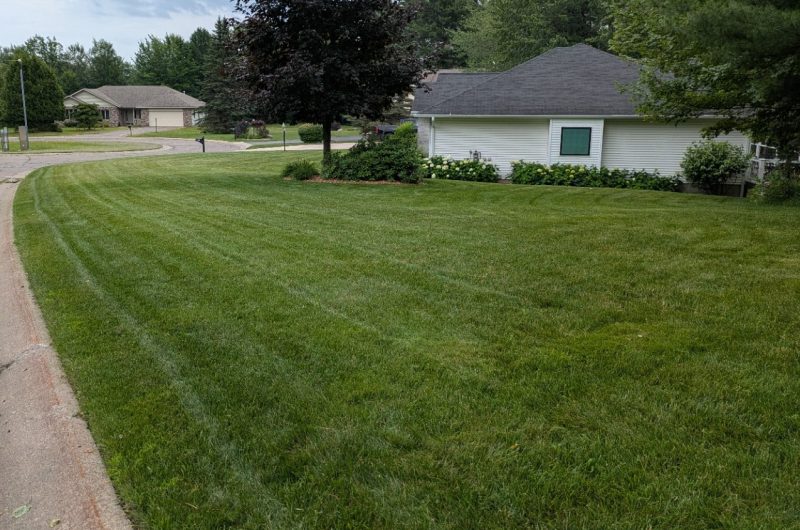Pictured Rocks Tourism Levels Likely Unsustainable Unless Action Is Taken

Over a hundred years ago, the UP began marketing its outdoors experiences to tourists. Today, that appeal remains for tourists wanting to hike, fish, canoe, kayak, snowshoe, cross-country ski, hunt, or simply relax and gaze into an unspoiled horizon.
Tourism is an important component of the U.P.’s economy: according to 2019 data from the Michigan Economic Development Corporation, it directly employed over 11,000 people, with total tourist expenditures amounting to $1.3 billion, and filled local and state coffers to the tune of $134 million in taxes.
From a sustainability perspective, tourism is a renewable resource, unlike the copper and iron ore that provided the basis for the region’s early wealth in the late nineteenth and early twentieth century. The natural environment can be enjoyed indefinitely–if it’s protected.
This article describes the life cycle of Pictured Rocks National Lakeshore, a notable UP tourist destination, using data from the National Park Service.
Any location enters its first stage as a tourist destination when enterprising people ‘discover’ it and tell others about their experience. The second stage begins when residents in the vicinity of the attraction offer services, such as food and accommodation, to tourists. The third phase is characterized by the development of a supporting tourist infrastructure with more hotels, restaurants, and specialized services, followed by a consolidation phase with continued construction.
Each succeeding stage is associated with an increase in tourist numbers until ‘stagnation’ occurs in a fifth stage, when the area’s original attractions are downgraded through overuse. This stage corresponds to overtourism, a word that entered the Oxford English Dictionary in 2018, and refers to a situation where the number of tourists adversely affects the host community and detracts from the quality of the tourist experience.
The sixth stage has a range of possible outcomes, which are dependent on destination management. Some destinations decline, with tourists no longer drawn to worn-down attractions. Others can flourish through the successful preservation of their signature draws.
Before European explorers ‘discovered’ Pictured Rocks in the mid-seventeenth century, the area was part of the land occupied by the Ojibwa. According to the official history of the Lakeshore, the region’s isolation meant that it was not until after World War II that the area became known to outsiders.
In the late 1950s, the National Park Service undertook a survey of the Great Lakes shoreline to determine areas suitable for inclusion in the National Park System. The survey identified 43 miles of shoreline in Alger County comprised of ‘unique and spectacular scenery’ that formed the basis for the National Lakeshore.
A decade or so later, Pictured Rocks National Lakeshore became part of the National Park System.
In each decade of the Lakeshore’s operation, the number of annual visitors has increased, except for the early 2000s. During the 1970s, the number of annual visitors averaged 291,000; by 2010-2019 this figure was 671,000, with the number of visitors exceeding 800,000 in 2018 and 2019.
Alongside the overall increase in tourist numbers there has been a steady rise in the number of overnight stays, from an annual average of 9,300 tent campers during the 1980s to over 14,000 during the 2010-19 period. The number of back country campers has similarly risen, almost doubling from an annual average of 10,000 during the 1980s to close to 20,000 for the 2010-19 period, while recreational vehicle stays have fluctuated over the decades.
Park visitation typically peaks in July and August; in 2019, these two months accounted for nearly half of the 859,000 annual visitors. Not only are the majority of park visits concentrated into a few months, they are geographically concentrated within the park.
The eastern region in the vicinity of Grand Marais with Grand Sable Dunes, Sable Falls and Log Slide has fewer visitors than the western portion that contains Miners Castle, Sand Point and Munising Falls. The Miners area is the most popular destination with 282,843 visitors in 2019, followed by Sand Point with 233,433 and Munising Falls at 208,117.
By contrast, the most popular destination at the eastern end of the park is Grand Sable Dunes with 151,576 people. Peak visitation for all sites coincides with the months of July and August.
The problems associated with the increased number of tourists to the park were well documented before the record number of 1.2 million visitors arrived in 2020. A 2019 Park Visitor Use Management Plan for the western portion of the park noted: “Visitor congestion has led to visitor conflicts; degraded visitor experience; safety concerns; resource damage along the shoreline, trails, and road sides; and inadequate facilities and infrastructure to accommodate visitor needs.”
Yet, despite these problems, tourists are undeterred. Visitors to the park in the first seven months of 2021 are running 167,000 above 2020’s record total.
To see peak tourism in action, the authors visited Miners Falls on two July weekdays. During both visits the parking lot was filled to capacity, forcing visitors to park their vehicles either side of the dirt road leading to the waterfall trail. The glut of cars added to the overall sense of congestion, while at the Falls’ observation area a number of visitors had climbed over the wooden fence and slid down to the river’s bank, adding to erosion in the area.
Figure 1. Tourists scrambling down the bank at Miners Falls.
The problems brought about by record visitation are not unique to Pictured Rocks. In July 2021, a US Senate Committee held a hearing to examine the effects of overcrowding in National Parks.
Witnesses were questioned on ways to mitigate overtourism without inhibiting access. Pictured Rocks’ capacity to deal with its newfound popularity is constrained by reduced staffing levels and a budget–$2.6 million–that has remained largely unchanged for the past decade.
The Lakeshore has never charged an entrance fee, unlike many National Parks in the West. Given Pictured Rocks’ budget constraints and its inability to address many of the management issues in the western portion of the Park, in May 2021 the Park Service proposed a fee structure, effective January 2022, and requested public comments.
The fate of the proposal is unclear at this time. Yet the life cycle model is clear: the Park is at a crossroads–its sixth stage.
A continuation of current visitor trends is not sustainable and will only lead to a further deterioration in the environment and an eventual loss of visitors. The proposed fee, if implemented, will be used to address the Park’s $10 million deferred maintenance deficit and implement the management strategies identified in the 2019 Visitor Use plan.
Pictured Rocks’ success in attracting visitors illustrates the conflict inherent in the National Parks’ mission, “to preserve unimpaired” natural resources “for the enjoyment, education, and education and inspiration of this and future generations.”
The challenge now is to find the right balance between preservation and accessibility.








We live in Grand Marais from May to September. The UP is the last somewhat unspoiled place within a day’s drive from millions of city people. Disrespectful ATV and snow mobile owners are destroying woodland and overwhelming small communities (just one example.)
All I can add is — this can’t go on. And it won’t go on because the situation will eventually break down driving away tourists, businesses, local residents over time. Theories of collapse say: it starts with one small element that overwhelms the rest of the system. Like a condo tower in Miami, or Interstate 35 bridge in Minneapolis.
you can’t throw snowmobilers under the bus. when the snow melts there is no sign of damage. snowmobiles run on snow that is plenty deep up here. atv’s are another story.
I beg to differ on no damage. With the off trail capabilities of some new snow machines there is an increasing amount of people that go deeper into the forest and depending on snow depth rip up parts of the forest floor. I have seen it myself once the snow has melted. But it is quite minimal. The larger issue is the side by side boom in the last several years. Most trails are torn to pieces dare I say by non locals that visit and do not care what things look like once the dust settles. Very sad…. and it is not ever going away.
I agree. The off-road ATVs and dirt bikes are a significant problem. But much of it is not tourist but rather local young people that have no respect for Nature like older locals.
The Michigan state park system manages to charge entrance fees. Enforcing a fee system would provide badly needed resources and perhaps moderate the crowds. People venturing off trail is a persistent problem in the NPS, but when I hiked the trail in 2017 my perception of the crowd at Miner’s Falls was that of locals heading to a local hangout. Charging fees might help moderate those behaviors.
We bought a camp here in 2002 with the intent of moving up here when we retired. We did that in 2012 and for a few years things were fine. However, with the influx of thousands of tourists, with not enough places to house and feed them, life here for us has gone down in satisfaction. We live on a river but never kayak down it due to extreme numbers of kayakers, their loud party attitudes and failure to respect the beautiful nature of the area. We live a few miles outside of Munising but never go there in the summer months as it makes up anxious and grumpy, due to the hundreds of cars not following basic driving rules. We are considering selling and moving away from here because it just isn’t what we were looking for and thought we found 20 years ago.
Yes, truly understandable.We moved up here in 1993, Manistique area.My husband works in Munising and has local co workers who are going through what you describe.Tourists were much mire resoectful previous to recent years.People’s camps and land have been taken over by camping ” squatters” , trash is being left, and degradation of the land is happening.In Manisrique we have been steadily busy with all campgrounds and rustic camping sites, booked continually since May.Traffic on US 2 and up on M28 has been crazy.Perhaps a Covid retirement boom has caused all this steady stream of tourists. IT certainly is unpleasant, because we local people have endured the long cold winters and have looked forward to the 5 months of lovely weather as our reward.Not any more.
You’re on the Au Train aren’t you. What did you expect?? You move up here without a clue and then proceed to whine about. Move back where you came from. You’re also part of the problem.
Sounds exactly like Door County. ☹️ I dislike living here for the same reasons. So sad!
I hear you! The exact same thing is happening to us in the Sleeping Bear Dunes area. We bought 15 acres adjacent to the park in 1993. Not too many people. Then some TV show called it “the most beautiful place in America”. And now it’s crowded such that we don’t go to many of the local trails and viewing locations in the park during the summer months. Funny thing… we talked about moving to where you are to get away from it. Guess not.
Seems the number of tourists is far lower than in reality ! In my area which is part of the national lake shore , I have snowmobilers stopping right in front of my house to take a leak , summer I have around 50 cars turn around in my driveway , then it’s the side by sides driving on the shoulder of the road instead of the trail across the road , this turns my lawn grey with dust , then there’s the trip to town for groceries , it’s eleven miles away , I nearly get hit head on every time !!! Then you get to the grocery store , shelves are empty no water , milk ,bread , fruit , amongst other items , price of gas is among the highest in the nation , propane shot up from $1.60 a gallon to $3.99 then try to rent a house or apartment , that’s $800 a week !!! I can’t take it anymore !!! I’m moving !!!
As I read these comments, it is with a sad sense of years’ worth of recognition and empathy. I am a “troll”, being roughly 25 miles south of the Mackinac Bridge and have lived in this area for nearly 70 years. The changes are so dramatic! Family owned businesses exchanged for distantly-owned ones with no ties to the community or way of life. Community! A word that struggles to maintain relevance. The “noise invasion” of mobile machines entertaining us to death. Summer, a season when one doesn’t have to drive so carefully due to snow, ice, and low-visibility has metamorphosed into one equally as dangerous…with metropolitan drivers aggressively commandeering the highways. In short, I understand your frustration with the often ill-mannered invasion (I like to envision an equal percentage increase of folks (here the summer increase is roughly 130%) descending on the metro areas for three months…not understanding the highway/street system, local practices, increasing litter, damage to lawns, parks, etc. with loud recreational vehicles). Hmmm. I hope some balance can be devised before too many folks who love this natural world leave in frustration, or we lose more of our cherished landscape. What we need here I think is “respect” for the land, waters, and local year-around inhabitants…which we will gladly reciprocate as earned.
Another example of people loving nature to death-with no regard for nature-i.e.noise, pollution, disruption of wildlife’s cycle of life-eating mating sleeping rearing young. Our species spell trouble for what is left of the wild. I enjoy quiet when I camp but now you have to go so far away to get peace. I get the residents frustration . I wish there were one answer but sadly even several fixes will not solve the people problem, just look at Yellowstone-I say send these people to Disney instead and let us enjoy the quiet.
They should do what Rocky Mountain National Park does and both charge an entrance fee and limit daily visitors through a reservation app “recreatiion.gov”. It limits entry flow into the park so it isn’t as congested, based on entry time windows and tourists can reserve ahead of time on the app during a planned vacation or in the case of Rocky Mountain National Forest 1/3 to 1/4 of reservation openings aren’t released until 24 hours before the day of visitation allowing for last minute or spontaneous reservations. Worked very well for my visit there this year.
sorry that’s recreation.gov
Agreed!
My thoughts exactly. Fee’s alone won’t do it. The number of daily visitors needs to be limited. Use the fee’s for maintenance and upkeep, limit the daily visitors to control erosion and impact.
I agree with you!
It does take planning and can be a hassle, but worth it to persevere some of the areas that are definitely overcrowded!
No doubt, Munising and Alger County need major help in managing this, not just from the state and federal government, but from experts to help figure out how to, basically, be a tourist town. The tourists aren’t going away, and as long as the activity is so heavily concentrated during the summer there is no way to support a year-round infrastructure with meaningful jobs and opportunities.
Along with what’s been recommended here about increasing the Pictured Rocks budget and considering park fees, there needs to be discussion about having more remote parking with bus access to sites, and most definitely about importing summer labor (most likely from outside the US) and figuring out where they will stay. There certainly are tourists who are downright disrespectful, but it seems like a lot of issues are related to the quick rise in tourism, the area’s declining population, and the need for more organized efforts on how to adjust to all this.
Fees, registration and shuttle service all seem reasonable and doable. There also needs to be some buy in from the surrounding state forest campgrounds which are “nonreservable”. Too many people heading to the area thinking they’ll “find a place”. Too often the solution when they can’t , is to boondock on private property.
I’m no fan of bureaucracy but funding a stronger Ranger presence seems necessary, as well.
Such a great read! Pictured Rocks is such a gem, but it’s true that the growing tourism levels are starting to feel like too much. I really appreciate how you highlight the need for action to protect the area—it’s something we can’t ignore if we want it to stay as beautiful as it is now. Thanks for starting this important conversation!